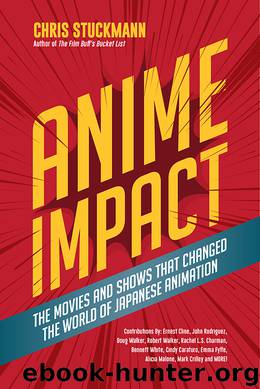Anime Impact by Chris Stuckmann

Author:Chris Stuckmann [Stuckmann, Chris]
Language: eng
Format: epub
ISBN: 9781633537330
Publisher: Mango Media
Published: 2018-03-12T14:28:46+00:00
2001 • Cowboy Bebop: The Movie
Kaubōi Bibappu: Tengoku no Tobira
— Chris Stuckmann —
How do you follow perfection? Should you follow perfection?
Shinichirô Watanabe dares to answer that question with Cowboy Bebop: The Movie, a feature-length tale set within the show’s previously established universe. Released in Japan in 2001, eventually making it to America in 2003, The Movie takes place between Episodes 22 (“Cowboy Funk”) and 23 (“Brain Scratch”). So, somewhere between the exploits of Teddy Bomber and Faye joining a cult, Spike battled Vincent and rushed to stop a deadly virus from spreading.
If you haven’t seen the show, I’ll avoid discussing the finale, but nevertheless, it was tough to contemplate where the characters could go from there. The choice to set this adventure between earlier episodes was a wise one. In so doing, Watanabe avoided needless exposition and kept from tarnishing his flawless ending. As a result, The Movie feels like an extended episode, but in the best way imaginable. Watanabe—along with writer Keiko Nobumoto—found a way to enliven their world, adding another rich layer to their character’s history, without undermining what they’d already accomplished.
The story is as follows: Halloween is around the corner, and a terrorist named Vincent is planning something deadly. Tanker trucks explode, viruses spread, and a record-breaking three hundred million woolong is posted as Vincent’s bounty. Obviously, this captures the attention of the Bebop crew—all of whom are starving and in desperate need of cash. Spike is tired of Cup O’ Noodles for dinner, Faye worries she isn’t getting any younger, while Jet concerns himself with the ship and money stress. Ed is … well, Ed.
As discussed in the Cowboy Bebop entry, Watanabe was very upfront about his cinematic inspirations, so I wasn’t surprised to learn that Watanabe originally envisioned his show as a movie, and treated each episode like a small feature. Perhaps this is why these characters—and Watanabe’s approach to them—mesh so well with the world of cinema. The operatic motifs of “Ballad of Fallen Angels,” or the haunting seclusion of “Pierrot le Fou” speak volumes for Watanabe as a visual storyteller. He translates his universe to the silver screen with panache, and even introduces some invigorating new characters.
Vicious was a deeply compelling villain in the series, sharing a personal connection with Spike that tormented them both. Establishing a new villain—one who has nothing to do with the overarching story—is a monumental task. Vincent is methodical and ponderous, often appearing to lose sanity for a time, waxing philosophical about Death and the Great Beyond. He’s a frightening physical presence, a towering man clothed in black. He’s the kind of cretinous existence capable of pressing a button and murdering thousands, without showing a hint of empathy. Worse yet, he feels his actions are justified, his tragic past the inciting incident that leads him down a path of butchery. As a physical opponent for Spike, he’s his most formidable. Where Vicious and Spike were equals, Vincent is Spike’s superior in battle. A ferocious beating on a monorail—one of the best scenes in the film—proves this.
Download
This site does not store any files on its server. We only index and link to content provided by other sites. Please contact the content providers to delete copyright contents if any and email us, we'll remove relevant links or contents immediately.
| Direction & Production | Genres |
| Guides & Reviews | History & Criticism |
| Reference | Screenwriting |
| Shows |
Head of Drama by Sydney Newman(2023)
Robin by Dave Itzkoff(2005)
I'm Judging You by Luvvie Ajayi(1891)
The Paranormal 13 (13 free books featuring witches, vampires, werewolves, mermaids, psychics, Loki, time travel and more!) by unknow(1848)
Single State of Mind by Andi Dorfman(1511)
Ten by Gretchen McNeil(1493)
#MurderTrending by Gretchen McNeil(1393)
Key to the Sacred Pattern: The Untold Story of Rennes-le-Chateau by Henry Lincoln(1351)
Most Talkative by Andy Cohen(1311)
Merv by Merv Griffin(1264)
Notes from the Upside Down by Guy Adams(1180)
This Is Just My Face by Gabourey Sidibe(1179)
Jamie Oliver by Stafford Hildred(1148)
The Hunger Games: Official Illustrated Movie Companion by Egan Kate(1118)
Springfield Confidential by Mike Reiss(1106)
Clarkson--Look Who's Back by Gwen Russell(1078)
The TV Writer's Workbook: A Creative Approach To Television Scripts by Ellen Sandler(1070)
Blue Planet II by James Honeyborne & Mark Brownlow(1021)
Dark Angel by D. A. Stern(1013)
